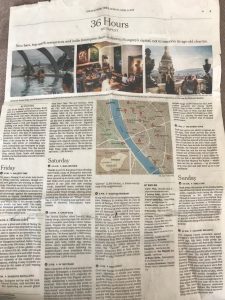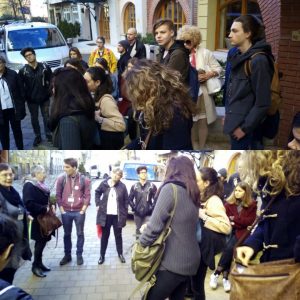I always encourage my guests to take public transport, it’s cheap, convenient and very easy. What’s more is that you can enjoy such a great view from the trams, buses or boats, don’t miss it!
I always encourage my guests to take public transport, it’s cheap, convenient and very easy. What’s more is that you can enjoy such a great view from the trams, buses or boats, don’t miss it!
When we are touring the Danube Bend I usually try to include the visit of the Castle complex including the Upper Castle and the Royal Palace, too.
The miracle that we are able to see how royals lived in the 15th century is due to a passionate Hungarian archeologist who had discovered the ruins of the palace in an orchid, we are tremendously grateful to the archeologists who recreated the lavish interiors of the Gothic-Renaissance palace.
The barely 5.000 sq feet stone house built in the 1300’s was rebuilt and extended several times and transformed to a fabulous royal residence with 350 rooms by King Matthias. Legend is that marble fountains were filled with red wine in the 15th century. The Gothic cloisters, Renaissance loggia, living quarters of our kings and queens, amazing fountains and gardens are to be seen in the Palace as well as items and relics from the Middle Ages.
The second largest park of Budapest, the locals’ favorite, a beautiful green oasis in the middle of Pest. There are so many things to do and to see in the City Park. You can visit the 150-year-old Budapest Zoo, the City Circus, enjoy the truly relaxing warm water of Széchenyi bathhouse, admire the various architectures of Vajdahunyad Castle or simply have a picnic topped with a boat ride on the lake.
Although Füvészkert seems to be hard to pronounce but it’s surely woth a try, as it’s a true hidden gem in the 8th district of Budapest.
The oldest and largest botanical garden of the city is from the 1770’s and is home to more than 7.000 plant species on a 3-acre area. The 150-year-old Chinese gingko is the oldest tree in the park.
You can admire the tropical and subtropical plants in the Palm House, Amazonas water lily in the Victoria glass house and the rich collection of palms, cactuses, bromelias and orchids. It’s one of the major locations in Ferenc Molnár’s ‘Paul Street Boys’, a famous Hungarian novel.
I love the evening tours, I tell my guests all the time that Budapest has two entirely different faces as it looks different during the day and during the night. My favorite building is the Parliament, it looks like a magnificent gingerbread cake with all the lights and colors of the night.
The largest Budapest park, the place chosen by princess Margaret when she gave up her life as a princess and started a new life in the monastery or an island where lepers lived isolated a long time ago; it is literally the favorite park of the Budapesters. I’m not a big fan of comparing places to other places but I can tell that it’s like our very own Central Park.
Unfortunately we very rarely include the visit of the island in the tours, because it’s a rather long walk from the city center. Still, when we do, my guests always appreciate it because it’s pretty, unique and it’s also an off-the-beaten-path experience.
The best method to discover the island is to rent a special bicycle for maximum 6 people. I’d suggest to ride all the way from the south to the north and not to miss the Japanese Garden, the Rose Garden, the small zoo, the Water Tower. Also, take some time to enjoy the music of the Musical Fountain.
I’m very much honoured because my Trabant tour will be included in a French TV show about Budapest. The idea is a really good one, it gives tips and recommendations about what to do in my lovely city when you visit Budapest for 2-3 days.
The filming was a very special experience for me, I can’t wait to see the cut version which I’ll share once I have it.
 I’ve received this article from three guests of mine at different occasions – and thank you so much guys for your preparations before your actual trip to Budapest. I need to tell that most of the places recommended by The New York Times are both fun and nice, still, I have the impression I can show you so much more when you come to visit my beautiful city.
I’ve received this article from three guests of mine at different occasions – and thank you so much guys for your preparations before your actual trip to Budapest. I need to tell that most of the places recommended by The New York Times are both fun and nice, still, I have the impression I can show you so much more when you come to visit my beautiful city.
Feel free to ask for my special recommendations!
We had the most exciting tour today about the Hungarian Samizdat press. I had the privilege to work with Kö zgazdasági Politechnikum in this great project: Building Democratic Europe Together – http://budet.poli.hu/
zgazdasági Politechnikum in this great project: Building Democratic Europe Together – http://budet.poli.hu/
My tour’s focus was the illegal, uncensored production, publishing and distribution of books and articles which couldn’t have been published in the Communist regime. It was all about conspiracy, clandestine operations and about how the state and state security tried to liquidate the entire movement, but more importantly my tour was about the desire to exercise free speech and free press, essential pillars of our new democracy.
It was great to see the enthusiasm of both students and teachers and I’m very proud to have been part of it.
Bathing and bathing culture have always been an important part of our everyday life. According to a survey I’ve just read 30% of the locals go to the baths regularly. It’s fun, very relaxing and has healing effects, too. I can show you some of the most authentic Budapest baths if you join me for a tour.
The Gellért bathhouse is the most elegant bath complex of Budapest. The building is one of the most amazing pieces of the Budapest Art Nouveau and opened in 1918. When you have a look at the richly ornate facade of the building its hard to imagine that before the construction of the elegant hotel, the place had been referred to as to the muddy baths, where both people and animals had their regular bath.
The thermal baths are fed by the mineral hot springs of the Gellért hill. The water is rich in calcium, magnesium, hydrocarbonate and sulfate. The water temperature varies from 35 °C to 40 °C.
Don’t miss the Turkish section where the walls are so nicely decorated with colorful mosaics. The bath can be visited throughout the year, if you happen to be in Budapest in the summer, you can also take advantage of the outdoor wave pool.